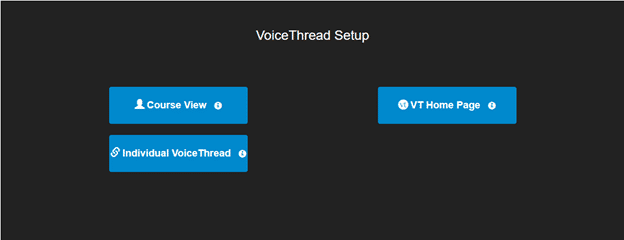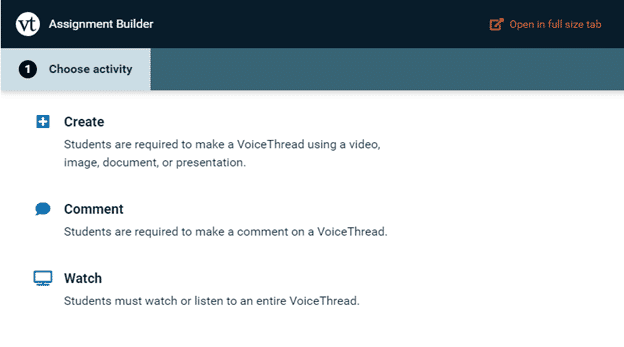In this module, you will learn how you can enable your students to develop, deliver, and discuss their asynchronous multimedia presentations online by using VoiceThread.
Why Online Presentations and Discussions?
Student presentations are an engaging experience but often require a big chunk of in-person class time for everybody to present.
For online or hybrid classes, what would be the best way for students to present and discuss their work?
Having students do presentations enables them to take an active role in the process of their learning. This process can help students strengthen their learning by allowing them to take responsibility for developing and delivering a presentation on the new knowledge they have acquired. Students will also be able to develop and improve their research, design, and communication skills, which are broadly applicable to their future employment. Student presentations can be used to facilitate peer learning. Students in the audience will be able to watch and learn from the presentations, especially if they are provided with an opportunity to ask questions or comment on the presentations.
In an in-person class, you might simply have presenters stand at the front of a classroom and utilize the overhead projector. In online and hybrid classes, live presentations can be conducted via video conferencing systems such as BlueJeans and Microsoft Teams.
No matter you are in-person or online, depending on the class enrollment, the presentations may require considerable class time. Because of the class time limit, this can result in having to cut many important aspects of presentations such as audience comments and discussions, instructor critique, or even limited presentation time to less than optimal amounts. Asynchronous presentations could help address these issues by giving students more time to develop their own presentations and an opportunity to reflect and comment on others'.
Technology for Online Presentation and Discussions: VoiceThread
About VoiceThread
VoiceThread (VT) is best used for creating, sharing, and commenting on assignments that involve the use of text, images, audio, and video. Some ideas and examples of its applications could include but are not limited to:
- self-introduction at the beginning of a semester
- project presentations
- digital storytelling
- practicing language learning
- discussing, debating, commenting, and providing feedback
VT is integrated with Canvas. While these learning activities might also be done with other tools in Canvas, the key advantage of VT is that it makes it easy for instructors and students to interact and communicate with multiple modalities.
What Can You Do with VoiceThread?
Add VoiceThread to a module or course navigation
You can add VT as a module item, which provides a link that you can set up to either go to a collection of your VTs for that course, the VT homepage, or direct students to a specific VT.
The VoiceThread link you can add to your course navigation homepage (through settings) will also allow for these options during the initial setup.
Configure a VT link
After you have added a VT link in your course (to a module or the course Navigation), you will choose what you want your students to see and do when they click that link. Here are four options for your configuration:
Course View: This option takes your students to the main VT page for your course, where they will see all the VTs shared with the course. VT Home: Display all of a student’s VoiceThread content in a single view. This includes all VoiceThreads they have made and all courses that belong to them. This option is useful if you want to create a simple portal into VoiceThread without directing students to any specific content. Individual VT: Display a particular Voice Thread you want to directly take students to. It is a good choice if you want students to view and/or comment on a specific VT.

Add VT as an assignment
When you create a VoiceThread Assignment in Canvas, you will need to select External Tools as the submission type, locate VT from the list, and select it.
After you have the Canvas assignment, you will see the same list of link options as when creating a VT link in a module, but there is 1 additional option called "Assignment Builder" that will help guide you through setting up VT as an assignment.

Create a VT assignment
You can create three types of assignments:
Create a VT: It requires students to create their own VT and submit it for grading. Submit a comment: It requires students to submit one or more comments on a VT of your choice. Watch a VT: Requires students to watch a VT of your choice from start to finish.

Grade a VT assignment
You may enter a percentage grade between 0 and 100. The corresponding assignment can have any point value you wish to assign to it. The percentage from VT will be multiplied by the point value to produce the correct number of points in the Canvas Gradebook.
You can also setup a VT assignment to be pass/fail and reward points based on completion alone.Remind students who have no submissions
You can send an email reminder to those students who have not yet submitted their assignments.
Student Gallery
Student Gallery is a great option for doing a peer reviewed assignment. Student Gallery allows students to see all student VoiceThread submissions for a single assignment in a single collection, separated from the other assignments.
Additionally, when finalizing the VT assignment you can select an option to "Allow students to view assignment after submitting" which will require that they submit their own VT submission before viewing others'.Create groups and contacts
Creating groups or contacts would allow you to share VTs with a specific group of students or an individual student.
Moderate comments
You can choose to moderate comments by reviewing all comments to make sure they are appropriate before releasing them to the class.
How Does VoiceThread Work?
Setting up VoiceThread in Canvas
The video tutorial below gives you an overview of how VoiceThread works in Canvas.
Please note that VoiceThread is going through a transition to a new assignment builder. As such, please ignore the VT assignment options in the Canvas video. If you are interested in using VT assignment, continue on down this page to view the updated VT assignment builder videos.
VoiceThread Assignments
The video tutorials below give you an overview of how to setup and use the different types of assignments in VoiceThread.
Grade VoiceThread Assignments
The video tutorial below gives you an overview of how grading works in a VoiceThread Assignment.
To learn more about using VoiceThread in Canvas please visit the vendor's documentation page for instructors.
To learn more about using VoiceThread for assignments, please visit this updated documentation page for instructors.
Strategies for Using VoiceThread
- Create a VT for students to practice using it: If students are expected to record and post audio and video for a graded assignment, it is ideal that they can practice and ensure that they are able to do that with their devices.
- Provide students with online netiquette guidelines: These guidelines will help you set expectations on creating a safe, friendly, and encouraging learning community for all the students. You can find from the attachment below an example of online discussion netiquette compiled by the Center for Teaching and Learning.
- Add close captioning to audio and video VTs: You can add closed captioning to your video or audio VTs and comments within VoiceThread. You can also encourage your students to do so.
- Direct students with disabilities to use VoiceThread Universal: VoiceThread Universal is an HTML version of VT that is made for screen readers. For students who have visual impairment and need accommodation, you may direct them to switch to VoiceThread Universal from his/her account.
Recommended Resources
VoiceThread Workshops: VoiceThread offers a variety of virtual workshops for training on how to use different features and functionalities of VoiceThread. You may register and attend those that interest you.
VoiceThread Digital Library: The digital library is a database of articles in which educators share their experiences of using VoiceThread in different disciplines.
Georgia Tech VoiceThread KnowledgeBase -This knowledge base article is maintained by the local OIT support for VoiceThread and will be updated to provide new information about VoiceThread features and other information.
Help & Support- If you encounter any issues using VoiceThread or have questions about how it works, you or your students can contact either VoiceThread support directly or reach out to the Georgia Tech Digital Learning Team.
Contributors
This module was compiled by the following CTL staff and was last updated on June 14, 2021.
- Chaohua Ou - Assistant Director, Learning and Technology Initiatives
- Vincent Spezzo - Program Manager, Teaching and Learning Online